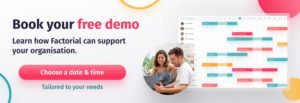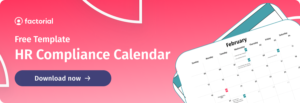Developing a robust and comprehensive HR tech stack is still a challenge for many organizations. These challenges can arise due to factors such as budget constraints, limited technical expertise, resistance to change, and the overwhelming variety of tools that are available these days. However, by failing to keep up with advances in HR technology, organizations risk missing out on the numerous benefits that a well-structured HR tech stack can bring.
But what is an HR technology stack exactly, and which tools should you include in yours?
In today’s comprehensive guide for employers, we will highlight the benefits of investing in an HR tech stack, including increased productivity, data-driven decision-making, and improved compliance. We will also explore which essential tools will help you enhance your tech stack and optimize your workforce management practices.
- What is an HR tech stack?
- Why have an HR tech stack?
- Types of HR tech stack tools available
- What to include in your HR tech stack
- An all-in-one solution for all of your HR needs
- 🚀 Centralize processes, customize reports, and make better decisions with Factorial’s business management software
What is an HR tech stack?
So, what does the term HR tech stack mean?
Put simply, an HR tech stack, short for an HR technology stack, refers to the collection of software applications and technology tools used by organizations to manage and streamline their human resources processes. It typically includes a combination of specialized software, systems, and platforms that handle various HR functions such as recruitment, onboarding, employee data management, payroll, performance management, and employee engagement. A HR tech stack enables automation, centralization, and integration of these and many other HR processes, enhancing efficiency and data accuracy, and facilitating strategic decision-making.
Ultimately, by integrating the right tools into your HR tech management system, you can create a cohesive and optimized HR infrastructure that supports your HR strategies and improves overall workforce management.
Why have an HR tech stack?
Companies need to get ahead now in order to leverage the potential of HR tech solutions, increase operational efficiency, and enhance overall workforce management. This is particularly important given that, according to the McKinsey Global Institute, half of today’s work activities could soon be automated.
Here are some specific benefits of implementing an HR technology stack in your business:
- Automation. HR tech tools automate manual tasks, reducing administrative burdens and freeing up HR professionals to focus on more strategic matters.
- Centralization. An HR tech stack centralizes employee data, improving accuracy, accessibility, and data integrity.
- Informed decision-making. Real-time HR analytics and reporting provide insights into workforce trends, enabling data-driven decision-making and strategic planning.
- Streamlined recruitment and onboarding. Applicant tracking systems (ATS) and onboarding platforms simplify and accelerate hiring processes, improving candidate sourcing, selection, and new hire experiences.
- Performance management. HR tech tools automate performance reviews, goal setting, and feedback collection, fostering a culture of continuous improvement.
- Employee engagement and collaboration. Tools like employee engagement platforms and collaboration software enhance communication, recognition, and teamwork, boosting employee satisfaction and productivity.
- Compliance and risk mitigation. HR tech tools ensure compliance with labor laws, regulations, and data privacy requirements, mitigating legal and financial risks.
- Scalability and flexibility. An HR tech stack can scale with organizational growth and adapt to changing needs, accommodating evolving HR requirements.
- Cost efficiency. While there may be initial costs, an optimized HR tech stack reduces manual processes, improves efficiency, and optimizes resource allocation, leading to long-term cost savings.
- Competitive advantage. Leveraging innovative HR technologies helps organizations attract top talent, enhance employer branding, and gain a competitive edge in the talent market.
Types of HR tech stack tools available
There are different types of HR tech tools on the market, which vary in terms of accessibility, installation requirements, and maintenance, among other factors:
- HR SaaS. HR SaaS refers to cloud-based software solutions that are hosted and delivered over the internet. These tools are typically subscription-based and provide HR functionalities that are accessible from any device with an internet connection.
- Legacy systems. Legacy HR systems refer to older, traditional software solutions. These systems are usually installed on-premises or hosted by the vendor, and they typically require significant investments in licensing, hardware, and maintenance.
- Open-source software. Open-source HR software provides the source code openly, allowing organizations to customize and modify the software according to their specific requirements. These tools offer flexibility and can be hosted either on-premises or in the cloud.
- Custom-built solutions. Some organizations develop their own custom HR software solutions tailored to their specific needs. This approach requires internal development resources or the engagement of external software development teams.
It’s important to note that the shift towards cloud-based HR SaaS solutions has been more prevalent in recent years due to their advantages in terms of accessibility, scalability, cost-effectiveness, and ease of maintenance. All other types, in contrast, usually require on-premises installations and internal maintenance. They are also usually more expensive in terms of upfront costs. Plus, customization can also be complex, and integration capabilities are often limited.
What to include in your HR tech stack
When building your HR tech stack, it’s crucial to consider the key components that will empower your organization’s HR operations. Selecting the right tools can help you achieve efficiency, scalability, and adaptability in your HR processes.
You should aim to include the following components in your HR tech stack diagram.
Core HR system
A core HR system, also known as an HRIS, is a software application that serves as the central database for storing, managing, and organizing essential HR data and employee information. Often integrated with document management software, this includes personnel records, organizational charts, job history, and compliance tracking. It provides a centralized location for HR professionals, once trained, to access and update employee data, generate reports, and perform basic HR tasks. Some also include self-service features for employees to access and update their own information.
This tool should be the foundation of your HR tech stack.
Applicant Tracking System (ATS)
An applicant tracking system (ATS), often used in combination with a talent acquisition platform, is a specialized tool that simplifies and automates the recruitment process. It streamlines job postings, candidate sourcing, resume screening, interview scheduling, and applicant communication.
Ultimately, an ATS enables organizations to efficiently manage the entire hiring process, improve candidate selection, and enhance the overall recruitment experience for both employers and applicants.
Performance management software
Performance management software facilitates ongoing performance evaluation, goal setting, feedback collection, and performance analytics. This helps you align individual and organizational objectives, track employee progress, identify development areas, and drive continuous performance improvement, helping you foster a culture of performance excellence.
Learning and development software
Learning and development software is a type of software that has been specifically designed to support and enhance employee training and development initiatives. It provides a range of tools and features that facilitate the creation, delivery, and management of learning content, as well as tracking and assessing employee progress and performance.
Payroll and benefits software
A payroll system automates the calculation, processing, and management of employee salaries, benefits, and deductions. With the right payroll software, you can ensure accurate, timely, and tax-compliant payroll processes and manage all your employee benefits. This helps you reduce manual errors, save time, and ensure employee satisfaction.
Time and attendance system
A time and attendance system is a software solution designed to track and record employee work hours. This includes when employees start and end their shifts, breaks, and any time off or absences. It typically involves the use of technologies such as biometric devices, time clocks, or digital interfaces to capture and store attendance data accurately. As a result, you can streamline workforce scheduling, manage absences, and ensure compliance with labor regulations.
In addition, many solutions can also be integrated with timesheet software. This is a project management tool used to record and track the specific hours worked by employees on specific projects or tasks.
Shift management tools
Shift management software streamlines the scheduling and management of employee shifts. These solutions allow organizations to easily create and manage work schedules. You can also assign shifts to employees, handle shift changes, and ensure optimal staffing levels. As a result, you can reduce scheduling conflicts and improve overall operational efficiency.
Employee engagement platform
An employee engagement platform fosters a positive work environment and enhances employee satisfaction and productivity. It offers features such as communication tools, recognition programs, surveys, and feedback mechanisms to promote employee engagement, collaboration, and well-being.
Ultimately, this platform facilitates effective internal communication, encourages employee recognition, and creates a sense of belonging and connection within the organization.
HR analytics and reporting tools
HR analytics software and reporting tools provide valuable data-driven insights that support strategic decision-making. These tools collect and analyze HR data, enabling organizations to measure workforce trends, identify areas for improvement, monitor key performance indicators, and make informed decisions to optimize their HR strategies and drive organizational success.
Onboarding and offboarding software
Finally, onboarding and offboarding software streamlines the process of integrating new employees and managing their departures. These tools automate tasks such as new hire paperwork, orientation, training, exit interviews, and offboarding documentation. This ensures a smooth transition and maximizes employee engagement and satisfaction throughout their journey with the organization.
An all-in-one solution for all of your HR needs
Factorial offers a comprehensive and customizable HR software solution that includes all the features you need to build an all-in-one HR tech stack.
Firstly, Factorial’s core HRIS acts as the foundation, centralizing employee data, managing records, and ensuring data accuracy, security, and accessibility.
Secondly, Factorial’s applicant tracking system (ATS) streamlines recruitment processes, helping you create a seamless talent acquisition process. Plus, compared to solutions such as the Breezy HR technology stack which focuses primarily on applicant tracking, Factorial’s comprehensive HR platform also includes built-in performance management features. That way, you can also track the performance of your employees throughout their entire lifecycle. You can automate performance reviews, set goals, and provide continuous feedback, fostering a culture of high performance.
Moreover, unlike other solutions like the Bamboo HR tech stack, Factorial’s all-in-one solution offers an advanced time and attendance tracking feature with geolocation tracking. This enables you to accurately track employee working hours through an electronic time clock. You can also use it to manage leave and ensure compliance with labor regulations. Plus, the solution connects all your HR tech stack data into a centralized and intuitive interface. That means you can easily integrate working hours into Factorial’s payroll and benefits software.
These are just a few examples of what Factorial’s comprehensive HR tech stack has to offer. Other features include employee engagement tools to help you promote collaboration, internal communication, and employee recognition; HR analytics and reporting tools that provide you with valuable insights to measure the impact of your HR strategies; and onboarding and offboarding tools that automate and facilitate a smooth transition for new hires and departing employees.
Ultimately, by consolidating these and many more features into a single HR software solution, organizations can centralize their workflows, optimize their workforce management processes, and enhance their overall HR operations.



